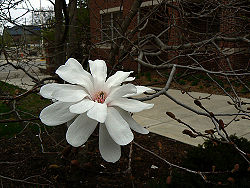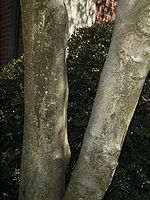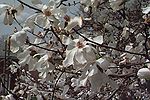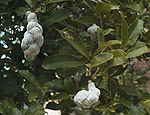Star magnolia
| Star magnolia |
|---|
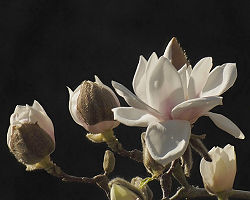
|
| Scientific Classification |
|
| Binomial Name |
|
Star Magnolia |
| Star magnolia bloomed flower, white colored with a hint of pink color, grown on the ends of the branches of the star magnolia tree |
The star magnolia is a species of magnolia trees with the scientific name Magnolia stellata. They grow as small trees or large shrub and are native to Japan. It was named after Pierre Magnol in the 17th century for its "starlike" features. The flower of the star magnolia has star shaped petals, which blooms in spring and is greatly admired for its beauty.
Anatomy
The name of this tree, comes from its star shaped flowers.[1] This plant is known as a tree or shrub.[2] The branches have a dark brown hue with a smooth trunk which leads up to twigged branches.[3] The branches of this tree are twig-like, thin, and with a chestnut color.[4] The bark texture of the star magnolia tree is smooth and somewhat shiny. The bark is seen as ornamental.[5] This trees bark and branches are light weight, heavy snow fall damage its soft wooded branches.[6] The leaves are as small as 4 in long by 1.5 in width. The tree leaves during autumn are yellow, bronze in fall, and green when fully bloomed.[7]The leaves maintain a green color throughout the maturely bloomed stage of the tree.[8] The star magnolia tree flowers, bloom during the late winter and early spring.[9]
The star magnolia's name comes from the flowers on the tree. The flower of this plant is star shaped. They range in length at about a minimum of 3 in, to a maximum of 4 in long. The flower is tree (or shrub) is white but turns pink when fully bloomed.[10] Flowers of the star magnolia plant grow from the top through the bottom of the tree.[11]The star magnolia also, produces a green-red fruit that is about 2 in long.[12] There are furry collections along the stems and branches of the plant which open up in the early spring. There are more than 30 petals per flower. Frost as well as wind determine the pink or white hue of the blooming flower. Throughout the season fruits and seeds begin to ripen. The large seeds are quickly noticeable because of the bright pink color. They have knobby capsules that are 2 to 3 in long. The fruit drops before maturity, which change to orange seeds during autumn. [13]
Reproduction
The star magnolia reproduces by seeds, and also reproduces by clonal growth. Which is also referred to by sprouting and layering. The flowers of this plant are both sexual and asexual, meaning there is a female and male part to this tree/shrub. This plant is pollinated or 'fertilized' by insects, this is how differentiation in species occur. The fruits of this tree are collected together by two red seeds per follicle. These may spread by birds, which eventually will produce more of these fruit.[14] The fruit and seed period occurs in the summer time. [15]
Ecology
Mostly grown in Asia, the Pacific Islands as well as the Western Hemisphere[16] the star magnolia is indigenous primarily to Japan.[17] From boarder to boarder, the star magnolia grows all over the united states.[18] The star magnolia is found in other regions such as Europe and North America.[19] This plant grows best in moist, organic, and fertile soil; rather than in very dry textured soil. Flowering is delayed due to implantation in colder locations or by spring frost. The star magnolia takes use of full sun, to grow and bloom well.[20] Cold stratification is unneeded for seed germination to occur or take place. The star magnolia does not grow or live through exposure to temperatures -8°F.[21] This plant tends to grow best at intermediate temperatures and hardly in extreme locations. 5 is the minimum pH and 6.2 is the maximum pH. This plant is medium acidic[22]
Cultivation / Uses
Star magnolia are commonly grown as bonzai. Repotting is done in the early spring when the flower buds begin and should only be done every three or more years. Star magnolia's do not require acidic soil, the pH of soil is kept at a moderate rate. A basic bonsai soil mix is best. Pruning a star magnolia usually takes place after flowering. In only about six weeks the star magnolia increases its rate in which it may grow rapidly. However the following spring, after pruning may result into little being able to do anything for graduation. Propagation in star magnolias are simply grounded or air-layered, during spring time. There are semi-cuttings around June. Star magnolias are disease free. The yellow leaves of the tree show a symbol of an alkaline soil, this helps to green the foliage. Spring is the ultimate time most insects kill and destroy this plant. The main pests to be aware of are scale insects, particularly around flowering time.[23]
Star magnolias are well known for their beautifully slow growing flowers.They are also known for their size, which tends to range from a large shrub or small tree. It is a sometimes potted or planted in a garden plant, that can sit outside of a porch, for its convenient size and shape. The star magnolia can last for years, and bloom for many years. This plant is easily managed, if put at right temperatures. This plant also gives an Asian garden feel to many gardens. Not only are the flowers that bloom off this shrub or tree beautiful, but, give a nice smelling aroma as well.[24]
Gallery
 Browse |
References
- Star Magnolia unknown Author. Absolute Astronomy. 2009.
- Floridata: Magnolia stellata Jack Scheper. Amazon.com. 08/16/97.
- Magnolia Stellata Mark H. Brand. UConn database. date unknown.
- Star Magnolia| Plant Information Author unknown. Hillclimb media. date unknonw.
- The star magnolia Harry Harrington. Boinsai Site. unknown date.
- Genetic variation and differentiation in populations of a threatened tree, Magnolia stellata: factors influencing the level of within-population genetic variation I Tamaki1, S Setsuko and N Tomaru. Heredity (2008) 100, 415–423; doi:10.1038/sj.hdy.6801097; published online 23 January 2008.
- Magnolia stellata (star magnolia) by the U.S. Department of Agriculture.
See Also
